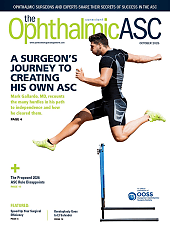Pterygium is a growth of fibrovascular tissue that typically grows from the nasal aspect of the conjunctiva and onto the surface of the cornea. Although we don’t fully understand its pathogenesis, one of the leading causes of pterygium is exposure to ultraviolet (UV) light, and as such, pterygia are often seen in patients who grew up in tropical or mountainous areas that have a lot of sun exposure. (In Australia, they call it “surfer’s eye.”)
Although small pterygia can remain asymptomatic, as they grow, they can cause irritation and may induce astigmatism.1 If allowed to become too large, pterygia can encroach on the pupillary axis, increasing the likelihood of visually significant scarring.2
In my practice, which is based in New York City, I treat a large population of patients who come from Caribbean and South American countries, so treating pterygia is a daily occurrence for me; there are even times where I may see up to 7 cases a day. Understanding when and how to best remove pterygia is vital for optimizing surgical outcomes and preventing disease recurrence.
When to Intervene
It can be difficult to determine the optimal moment to perform a pterygium removal. In many patients, pterygia border on the limbal surface and will remain small and asymptomatic. In these cases, it’s often best to encourage sun protection to prevent UV light from stimulating pterygium growth, and continue monitoring for progression. Operating on small, asymptomatic pterygia is not always the best course because the operation can set off a cascade of events that leads to recurrent pytergia,3 which requires more difficult surgical management than primary pterygia.
On the other hand, we also don’t want to let pterygia get to the point where they are causing corneal scarring. In such cases, even if removal is successful and scarring is limited, the patient may still end up with visually significant corneal astigmatism.4
Therefore, the ideal time for pterygium removal is usually after it has crossed over the limbus, but before it has reached the pupillary axis. In my experience, this is typically when the head of the pterygium grows approximately 1.5 mm to 3.0 mm onto the corneal surface. This usually requires the removal of an 8 mm x 10 mm lesion of conjunctival and corneal tissue.
Preoperative Considerations and Patient Counseling
Prior to performing a pterygium excision, it is vital to ensure that ocular surface inflammation is reduced as much as possible. As such, when a patient presents to my office with pterygium, my first step is to assess for common ocular comorbidities such as Demodex blepharitis or rosacea, both of which contribute to ocular surface inflammation. Addressing these comorbidities with appropriate therapies before surgery can ensure the operation occurs in an environment that is as uninflamed as possible. This can reduce bleeding during surgery, promote faster postoperative healing, and achieve better surgical outcomes.
Preoperatively, patient counseling includes discussion of cosmetic considerations, as these are often important motivating factors driving patients to undergo pterygium excision. It is important to let patients know that this isn’t like some other ocular surgeries where the next day they can look in the mirror and not even be able to tell that their eye has been touched. With pterygium removal, patients may experience redness for up to a month postoperatively, and they will feel like they’ve had surgery. In general, when we can proactively help patients understand the surgery, and anticipate the postoperative course, they can take it in stride; issues that surface after the fact often take on greater weight.
Cryopreserved Amniotic Membranes and Conjunctival Autografts
A helpful option for pterygium excision is cryopreserved amniotic membranes (CAMs). As of press time, Prokera, AmnioGraft, and AmnioGuard by BioTissue Ocular Inc. are the only CAMs available. Although initially I only used CAMs for cases where lesions were so large (often double pterygia) that I couldn’t harvest enough conjunctiva to perform a conjunctival autograft, I now use CAMs in nearly 100% of my pterygium excision cases.
For many patients, a conjunctival autograft is still the gold standard for reducing pterygium recurrence. However, the anti-inflammatory and antifibrotic properties of CAM, which are well documented,5 may contribute to decreasing recurrence rates. I now use it even in cases in which I am also doing a conjunctival autograft.
When performing a pterygium excision, CAM can be used in two particular places. First, when I harvest the autograft from the superior conjunctiva, I will place a CAM over that site to close off the tenons and sclera, using fibrin glue (Tisseel; Baxter International, Inc.) to secure it in place. Anecdotally, this can help reduce pain as well as the number of pyogenic granulomas that develop postoperatively.6
Another important surgical recommendation is to place CAM in the area of the conjunctival defect from which the pterygia was removed, and try to customize the graft to the size of the defect. Originally, I would place just a thin strip of CAM deep into the fornix to act as a barrier to recurrence, but using only a small amount of material was challenging to work with. A larger piece of the membrane, usually roughly 8 mm x 8 mm or 8 mm x 6 mm, is much easier to work with, and I will place that over the muscle and fill in the defect. In this way, half of the graft is underneath the conjunctiva and into the fornix, and the other half is on the sclera, but not all the way up to the limbus, leaving 3 mm or 4 mm of scleral tissue between the CAM and the limbus.
Once I place the first CAM, I will put glue over it to secure it in place and, with the glue at the same time, I will secure the conjunctival autograft right above it, to “sandwich” the CAM, glue, and conjunctiva.
These two CAM placements have a multifactorial effect: they not only act as a barrier against pterygium regrowth, but their anti-inflammatory and anti-fibrotic properties keep the eye “quiet” and promote better postoperative healing.
Postoperative Patient Counseling
Proper adherence to the postoperative regimen is vital to achieving optimal outcomes and preventing the emergence of recurrent pterygia. It is therefore very important to discuss the necessary steps with patients following surgery; one thing I try to let patients know is that although their eyes will be red for a period of time, this is normal, transient, and not a cause for concern. Another thing I try to emphasize is the need for proper, frequent lubrication, and use of anti-inflammatory medication to help prevent recurrence. I explain to patients that recurrent pterygium is very different and more difficult to manage than primary pterygium, and that if we can do a good job the first time, we can really save them a lot of trouble in the long run.
Treatments on the Horizon
A pharmacologic therapy is being tested for preventing pterygium progression. The safety and efficacy of a topical multikinase inhibitor nintedanib (Cloudbreak Pharma) is currently being investigated in a 24-month phase 3 clinical trial.7
Conclusion
Applications of CAM could expand in the future to conditions such as dry eye disease. There may also be a role for newer, more comfortable preparations, like CAM360 AmnioGraft (CAM360 AG; BioTissue Ocular, Inc.). With CAM360 AG in particular, I expect that as I use it more in my practice, I will continue to find patient situations and indications where it performs best. Ophthalmology is trending toward greater use of new options like CAM, both as a replacement for conjunctiva, when necessary, and as an anti-inflammatory adjuvant to treatments. (See “The Complex Difference of CAM” on p. 20 of this issue.) Elsewhere in medicine, use of CAM is likewise growing, especially where wound healing is important (eg., orthopedic surgery, diabetic ulcers).8
As a field, ophthalmology has come a long way toward the ability to safely and effectively manage pterygium excision. Patients used to tell me postoperatively that this surgery was more painful than childbirth. New tools and therapies will make this surgery much more tolerable and effective. OM
References
- Chu WK, Choi HL, Bhat AK, Jhanji V. Pterygium: new insights. Eye (Lond). 2020;34(6):1047-1050. doi:10.1038/s41433-020-0786-3
- Gasser T, Romano V, Seifarth C, Bechrakis NE, Kaye SB, Steger B. Morphometric characterisation of pterygium associated with corneal stromal scarring using high-resolution anterior segment optical coherence tomography. Br J Ophthalmol. 2017;101(5):660-664. doi:10.1136/bjophthalmol-2016-308685
- Ghiasian L, Samavat B, Hadi Y, Arbab M, Abolfathzadeh N. Recurrent pterygium: a review. J Curr Ophthalmol. 2022;33(4):367-378. doi:10.4103/joco.joco_153_20
- Ozgurhan EB, Kara N, Yildirim A, Alkin Z, Bozkurt E, Demirok A. Diamond burr superficial keratectomy with mitomycin C for corneal scarring and high corneal astigmatism after pterygium excision. Clin Ophthalmol. 2013;7:951-954. doi:10.2147/OPTH.S45748
- Navas A, Magaña-Guerrero FS, Domínguez-López A, et al. Anti-inflammatory and anti-fibrotic effects of human amniotic membrane mesenchymal stem cells and their potential in corneal repair. Stem Cells Transl Med. 2018;7(12):906-917. doi:10.1002/sctm.18-0042
- Yang MB, Melia M, Lambert SR, Chiang MF, Simpson JL, Buffenn AN. Fibrin glue for closure of conjunctival incision in strabismus surgery: a report by the american academy of ophthalmology. Ophthalmology. 2013;120(9):1935-1941. doi:10.1016/j.ophtha.2013.05.008
- A clinical trial on safety and efficacy of CBT-001 in patients with pterygium. ClinicalTrials.gov identifier: NCT05456425. Updated September 24, 2025. Accessed June 16, 2025. https://clinicaltrials.gov/study/NCT05456425.
- Parmar UPS, Surico PL, Scarabosio A, et al. Amniotic membrane transplantation for wound healing, tissue regeneration and immune modulation. Stem Cell Rev Rep. 2025 May 14. doi: 10.1007/s12015-025-10892-x. Epub ahead of print.









